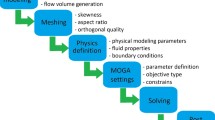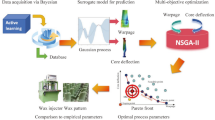Abstract
Flowforming is an incremental forming technique which is used to manufacture seamless tubes with high precision and surface quality. Internal gear flowforming process (IGFP) is an interesting topic in which there is no need for costly tooling and high forming forces. In this research, the formation of internal gears by flowforming and the effects of process parameters on built-up edge are investigated and then optimized. First, the process is analyzed and simulated. Second, several controlled tests are accomplished to verify the simulation results. Third, the effects of feed rate, thickness reduction percentage, attack angle, and roller diameter, on built-up edge are obtained using design of experiments procedure (DOE). Fourth, simulated annealing (SA) algorithm and genetic algorithm (GA) are used for optimizing built-up edge. According to DOE, the most significant parameters affecting the built-up edge are: attack angle, thickness reduction percentage, and feed rate. The built-up edge increases with increasing the attack angle, feed rate and thickness reduction percentage. Optimization results show that the minimum value of the built-up edge is equal to 0.449 mm in SA and 0.445 mm in GA.















Similar content being viewed by others
Abbreviations
- IGFP:
-
Internal gear flowforming process
- ALE:
-
Arbitrary Lagrangian–Eulerian
- RSM:
-
Response surface method
- CCD:
-
Central composite design
- ANOVA:
-
Analysis of variance
- DF:
-
Degree of freedom
- SS:
-
Sum of squares
- MS:
-
Mean of squares
- SA:
-
Simulated annealing algorithm
- GA:
-
Genetic algorithm
- VMM:
-
Video measuring machine
- D :
-
Roller diameter (mm)
- T :
-
Thickness reduction (%)
- f:
-
Feed rate (mm/rev)
- α :
-
Attack angle (degree)
- S:
-
Circumferential contact length (mm)
- L:
-
Axial contact length (mm)
- t0 :
-
Initial thickness (mm)
- tf :
-
Final thickness (mm
References
Podder B, Banerjee P, Ramesh Kumar K and Hui N B 2018 Flow forming of thin-walled precision shells. Sādhanā 43: 208
Wang X, Gao P, Zhan M, Yang K, Dong Y and Li Y 2020 Development of microstructural inhomogeneity in multi-pass flow forming of TA15 alloy cylindrical parts. Chin. J. Aeronaut. 33: 2088–2097
Gao P, Yu C, Fu M, Xing L, Zhan M and Guo J 2021 Formability enhancement in hot spinning of titanium alloy thin-walled tube via prediction and control of ductile fracture. Chin. J. Aeronaut.
Gao P F, Li M, Zhan M, Xing L, Ma F and Fu M W 2021 Circumferential twist in flow forming of tubular parts: Characterization, understanding and control. J. Manuf. Processes. 65: 144–152
Srivastwa A K, Singh P K and Kumar S 2021 Experimental investigation of flow forming forces in Al7075 and Al2014: A comparative study. Mater. Today: Proc. 47: 2715–2719
Guba N, Hüsemann T and Karpuschewski B 2020 Influence of gear hobbing feed marks on the resulting gear quality after discontinuous profile grinding. CIRP J. Manuf. Sci. Technol. 301: 304–321
Nägele H, Wörner H and Hirschvogel M 2000 Automotive parts produced by optimizing the process flow forming: machining. J. Mater. Process. Technol. 98: 171–175
Groche P and Fritsche D 2006 Application and modelling of flow forming manufacturing processes for internally geared wheels. Int. J. Mach. Tools Manuf. 46: 1261–1265
Jiang S-Y, Ren Z-Y, Bin W and Wu G-X 2007 General issues of FEM in backward ball spinning of thin-walled tubular part with longitudinal inner ribs. Trans. Nonferrous Met. Soc. China 17: 793–798
Jiang S, Ren Z, Xue K and Li C 2008 Application of BPANN for prediction of backward ball spinning of thin-walled tubular part with longitudinal inner ribs. J. Mater. Process. Technol. 196: 190–196
Jiang S, Ren Z, Li C and Xue K 2009 Role of ball size in backward ball spinning of thin-walled tubular part with longitudinal inner ribs. J. Mater. Process. Technol. 209: 2167–2174
Jiang S-Y, Zheng Y-F, Ren Z-Y and Li C-F 2009 Multi-pass spinning of thin-walled tubular part with longitudinal inner ribs. Trans. Nonferrous Met. Soc. China 19: 215–221
Haghshenas M, Jhaver M, Klassen R and Wood J 2011 Plastic strain distribution during splined-mandrel flow forming. Mater. Des. 32: 3629–3636
Haghshenas M, Wood J and Klassen R 2012 Investigation of strain-hardening rate on splined mandrel flow forming of 5052 and 6061 aluminum alloys. Mater. Sci. Eng. A 532: 287–294
Haghshenas M, Wood J and Klassen R 2012 Effect of strain-hardening rate on the grain-to-grain variability of local plastic strain in spin-formed fcc metals. Mater. Sci. Eng. A 552: 376–383
Xia Q-X, Sun L-Y, Cheng X-q and Ye B-Y 2009 Analysis of the forming defects of the trapezoidal inner-gear spinning. In: Industrial Engineering and Engineering Management, IEEE International Conference, pp. 2333–2337
Xia Q, Long J, Xiao G, Yuan S and Qin Y 2021 Deformation mechanism of ZK61 magnesium alloy cylindrical parts with longitudinal inner ribs during hot backward flow forming. J. Mater. Process. Technol. 296: 117197
Xu W, Zhao X, Shan D, Li J, Deng Q, Cui X and Li Z 2016 Numerical simulation and experimental study on multi-pass stagger spinning of internally toothed gear using plate blank. J. Mater. Process. Technol. 229: 450–466
Khodadadi M, Khalili K and Ashrafi A 2020 Studying the effective parameters on teeth height in internal gear flowforming process. Int. J. Eng. 33: 2563–2571
Khodadadi M, Khalili K and Ashrafi A 2021 Study on manufacturing of internal gear by flowforming process and investigation of effective parameters on process force. IJMF 8: 14–25
Marcon A F, Bittencourt E and Creus G J 2000 Single-test determination of the friction coefficient and stress-strain curve for application in metal-forming analyses. Exp. Mech. 40: 124–128
Selçuk B 2011 Feasibility of utilizing response surface methodology for predicting wear of steels. Proc. Inst. Mech. Eng. Part J: J. Eng. Tribol. 225: 277–287
Montgomery D C 2001 Design and analysis of experiments. fifth edition United States of America John wiley & sons chapter 2,3
Author information
Authors and Affiliations
Corresponding author
Ethics declarations
Conflict of interest
The authors declare that they have no competing interests.
Rights and permissions
About this article
Cite this article
Khodadadi, M., Khalili, K. & Ashrafi, A. Optimizing parameters effective on built-up edge in internal gear flowforming process. Sādhanā 47, 99 (2022). https://doi.org/10.1007/s12046-022-01860-z
Received:
Revised:
Accepted:
Published:
DOI: https://doi.org/10.1007/s12046-022-01860-z




